Amid Drug Shortages, Alternative Treatments for Fever and Cough
With the present shortages of over-the-counter medicines for coughs, colds, and flu, this seems like the perfect time to talk about natural remedies. These can be helpful when we either don’t have medications on hand, or simply want a more natural approach to dealing with common illnesses. Natural medicines are beneficial as they are non-toxic and support our body’s own healing process. If used at the first sign of illness, many can shorten its severity and duration. Here are some natural approaches—many used by cultures worldwide for centuries—to help get you back into tip-top shape.
Treatments for Fever
Fevers are our bodies’ natural reaction to infection. A fever is part of a healthy immune response and communicates that we are mounting an appropriate defense against an unwanted invader. As parents, it is always difficult seeing our children sick, and it is our instinct to do whatever we can to make them feel better.
In the case of fevers, unless they are very high, it can be beneficial to let the fever do the work of fighting the infection. Fevers slow down pathogens and their replication; therefore, a fever slows down the spread and severity of an illness.
If a fever gets too high (104+), it’s a good idea to get it down. This is the work of many drugs, but this can also usually be achieved with a lukewarm or cool bath. Eating will also usually bring a fever down slightly if you or your little one feel up to it. Very high fevers burn fluids and increase the risk of dehydration. Make sure to drink plenty of clear liquids, and children can have water or diluted fruit juice for hydration and to keep blood sugar within normal range. Fevers also deplete vitamin A, so be sure to supplement with vitamin A-rich foods (like fish oils, kale, spinach, broccoli, milk, and eggs) after a bout with a fever.
Yarrow (Achillea millefolium)
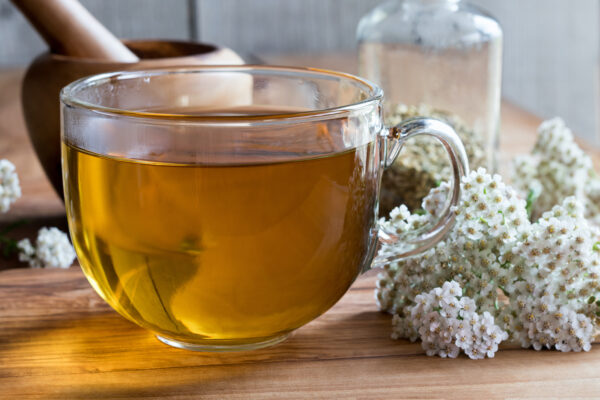
Yarrow is a common herb and is well known for its ability to bring down a fever. It is considered a diaphoretic herb, meaning it makes you sweat, helping the body eliminate toxins through the skin and urine. Yarrow also purifies and moves the blood, treats urinary infections, and heals wounds.
In a comparative study in the Pakistan Journal of Pharmaceutical Studies, yarrow demonstrated the ability to significantly reduce fevers in animal models.
A research review published in Current Pharmaceutical Design in 2008 discussed the traditional use of yarrow for this purpose. “The genus Achillea consists of about 140 perennial herbs native to the Northern hemisphere. Traditional indications of their use include digestive problems, liver and gall-bladder conditions, menstrual irregularities, cramps, fever, wound healing,” it noted.
A review on the biological activities of yarrow published in the Journal Current Pharmaceutical Design, mentions yarrow’s analgesic, anti-ulcer, choleretic (which stimulate the production of bile by the liver), liver protecting and wound healing abilities and that data has accumulated demonstrating its antioxidant and anti-inflammatory effects.
Yarrow regulates blood flow to the entire body and, with its ability to induce sweating, helps regulate body temperature and fluids—eliminating heat and toxins and reducing a fever.
The dried herb can be bought online and at some health food shops. Always try to buy organic when possible to avoid pesticides and other chemicals.
For fevers, drink yarrow tea (instructions below) or add 8 cups of yarrow tea to a hot bath.
Yarrow Tea
For tea, pour 1 cup of boiling water over 1 to 2 teaspoonfuls of the dried herb and leave to infuse for 10 to 15 minutes. Drink this tea three times a day. For a fever, drink the tea hot hourly.
Ginger ( Zingiber officinale)
Ginger is warming in nature and induces sweating, helping treat fevers and eliminate toxins. It is also used as a stimulant for problems with circulation and to soothe digestive issues.
The results of one clinical trial, published in Phytotherapy Research in November, 2022, found a combination of four plants commonly used in Ayurvedic medicine (ashwagandha, boswellia, ginger and turmeric) was effective on hospitalized moderate COVID-19 patients who received it, along with standard care.
The mixture, dubbed BV-4051 by the researcher, had noted effects.
“In BV-4051 group the mean reduction in duration of illness (p = 0.036), alleviation and severity scores of several symptoms like fever, cough, smell, and taste disorders were statistically significant,” they wrote.
A research review published in Phytomedicine: International Journal of Phytotherapy and Phytopharmacology, in 2005 summarized previous research on the herb using animal models.
“Animal studies demonstrate effects on the gastrointestinal tract, the cardiovascular system, on experimental pain and fever, antioxidative, antilipidemic and antitumor effects, as well as central and other effects,” wrote the researchers.
In Chinese medicine, fresh ginger is called sheng jiang. It is a warming herb used to induce sweating, disperse cold, benefit a cough, and alleviate nausea and vomiting.
Ginger Tea
Cut a slice or two of fresh ginger root, put it into a pot of water, and bring to a boil. Then drink as a tea. Add lemon (high in vitamin C) or honey to taste. The tea will help to induce sweating, bring down a fever, soothe any digestive upsets, and help a cough. Hot ginger tea taken at the first sign of a cold or flu can help the body build resistance and avoid infection.
Boneset (Eupatorium perfoliatum)
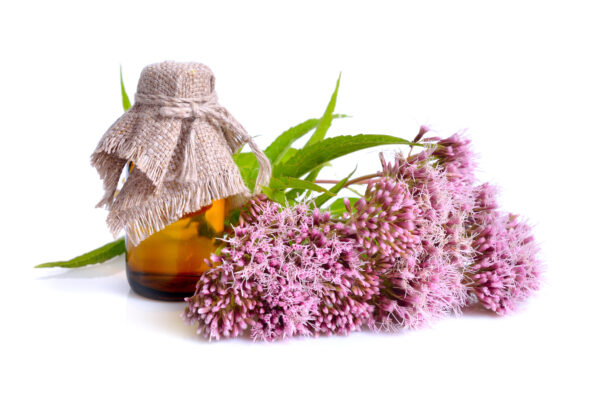
Boneset is an excellent herb to treat fevers and is a great choice for colds, the flu, and respiratory infections. It can be used for phlegm, as it discourages its production and helps eliminate it from the body. Boneset also fights bacterial and viral infections and makes you sweat, helping reduce a fever. Boneset will also help ease the aches and pains associated with the flu and helps clear the body of any build-up of toxins through the bowels.
“E. perfoliatum extract has marked antiviral activity,” notes a study published in Journal of ethnopharmacology in January 2022. The researchers were studying the effects of the plant in vivo for treatment of dengue virus.
Boneset Tea
The dried herb can be bought at most health food shops and made into a tea. Pour a cup of boiling water over 1-2 teaspoonfuls of the dried herb and leave for 10-15 minutes. It should be drunk as hot as possible. For treatment of fevers or flu, drink every half hour.
*Boneset should not be used by pregnant women or young children and is not recommended for long-term use.
Lukewarm Baths
If a fever gets above 103, it’s a good idea to bring it down. This can usually be achieved by getting into a lukewarm or cool bath. Although this is not comfortable initially, it will temporarily lower your body temperature and reduce a fever if it gets too high. If a bath sounds too drastic, you can take a face cloth soaked in cold water and hold it up to the creases in your elbows and behind your knees to help gently reduce body temperature. Remember to keep hydrated with water, clear liquids, or diluted fruit juice.
Cough
Cough suppressants may alleviate the symptoms of coughing but other treatments can offer similar relief with additional benefits.
Honey
Raw honey has antibacterial, antimicrobial, and anti-inflammatory properties and has been used throughout history as a cough suppressant. It can help with seasonal allergies and lowers blood pressure and cholesterol. I prefer to use raw honey as the pasteurization process undergone by regular honey destroys many of its natural medicinal properties.
In a clinical trial published in the archives of pediatrics and adolescent medicine, one hundred and five children aged two to eighteen were given either honey, honey flavored dextromethorphan (DM) or no treatment. Of the three treatments, parents rated honey the most favorably for symptomatic relief of their child’s nighttime cough and difficulty sleeping due to a respiratory tract infection.
Honey is known as feng mi in Chinese medicine. It benefits the digestive system and is very moisturizing, particularly to the lungs. It also has a mildly laxative quality, so it should be consumed with caution if you are prone to loose stools—although its lubricating quality makes it a great treatment for constipation. Because of honey’s impressive health benefits, it is also commonly used as a daily tonic.
For a cough, take a spoonful of raw honey directly or use it to make a natural cough syrup. Taking a spoonful of raw honey twice a day will benefit a cough and help to moisturize the throat.
*Never give honey to a child less than one-year-old. Clostridium, a bacteria that causes botulism, can contaminate some foods—including honey. As a child grows, their immune systems develop and can handle the bacteria.
Honey Water
Drinking warm water with raw honey increases its moistening and lubricating effects and is beneficial for a dry cough, sore throat, and constipation. It can be drunk as needed for cough and symptoms of dryness.
Ginger
Ginger is an excellent remedy for coughs and helps to eliminate phlegm and other toxins from the body. Just add a few fresh slices of ginger root to a pot of water and bring to a boil, then drink as a tea to receive its beneficial effects. (see above in fevers).
Thyme (Thymus vulgaris)
Thyme has antiviral, antibacterial, antifungal, and antiparasitic properties. It strengthens the immune system and is an excellent remedy for coughs.
Thyme is a strong antiseptic and makes a good gargle that can be used for bronchitis, laryngitis, tonsillitis, and whooping cough. It is an excellent remedy for irritating coughs as it is an expectorant and soothes spasms. It is also beneficial for sore throats.
Thyme can be used as an essential oil or tea to boost the immune system, and a gargle is beneficial for treating throat problems and coughs. Be aware that thyme essential oil is very strong, must be diluted in a carrier oil, and should only be used externally.
A review in a Polish Journal in 2016 studied thyme for coughs associated with upper respiratory tract infections. It noted that thyme is a spasmolytic, antimicrobial, anti-inflammatory, immunomodulatory and antioxidant agent, and found that using a drug with the addition of extracts from thyme and primrose alleviated the effects of cough and shortened its duration.
Thyme Tea & Gargle
To make tea, pour 2 cups of boiling water over two teaspoons of the dried herb and let it infuse for ten minutes. Drink three times a day.
You can dilute the tea with additional water, let it cool, and use it as a gargle.
Cleanse & Detoxify The Body
Your body is constantly flushing out cellular debris and various byproducts from metabolism, not to mention unwelcome substances we’ve eaten (additives, preservatives, etc) or absorbed from our cosmetics. We can help the body with these processes in several ways, including drinking plenty of pure water and eating a clean diet.
Epsom Salt Baths
Epsom salt baths are a wonderful way to relax the body and ease the pain of sore muscles. Epsom salts contain magnesium sulfate (made up of magnesium, sulfur and oxygen) which, when dissolved in a hot bath, are thought to be absorbed through the skin. Magnesium helps ease sore muscles, and the sulfur in Epsom salts is thought to help the body release toxins. The key is to drink lots of water before, during, and after an Epsom salt bath to maximize its full detoxifying effects. Use 1 cup of Epsom salts in a warm bath and soak for at least 30 minutes to achieve the full benefits.
Baths with Essential Oils
When you are not feeling your best, there is nothing more soothing than a hot bath. The warm water opens pores, can aid congestion, and help the body and mind to relax. Every essential oil has different qualities, so choose the ones that will benefit you and your symptoms. Add 4-6 drops to a warm bath to enjoy their healing benefits.
Lavender (Lavandula angustifolia and others)
Lavender is relaxing to the nervous system and helps with achieving restful, relaxing sleep. Lavender has also been proven effective for improving symptoms of anxiety and depression.
A study published in 2012 found that participants inhaling lavender essential oil had a significant decrease in blood pressure, heart rate, and skin temperature, and that those using the oil were more relaxed and had increased brain activity. Another study published by the Journal of Psychiatry found that using 80 milligram capsules of lavender essential oil helped alleviate anxiety, sleep disturbances and depression. The study also noted that there were no adverse effects or drug interactions when using lavender essential oil.
Frankincense
Frankincense can be used for congestion, to reduce the symptoms of a cold or flu, and to stimulate the immune system. It also helps clear the mind and enhance mood.
In a lab study conducted by researchers at Mansoura University in Egypt found that frankincense oil strongly stimulated the immune system.
Chamomile (Roman or German)
Chamomile is relaxing, beneficial for anxiety and depression, and is a strong anti-inflammatory and pain reliever.
A research study in the Journal Alternative Therapies in Health and Medicine found that chamomile provided significant antidepressant activity. Chamomile also combines well with lavender for its soothing, calming effects.
Orange
Orange is a beautiful oil for reducing stress, muscle tension, and anxiety.
A 2014 study published in the Journal of Complementary Therapies of Medicine found that inhaling orange and rose oils causes physical as well as psychological relaxation.
Rose
Rose is a particularly beneficial essential oil for the skin, so adding it to a warm bath will open pores and leave your skin feeling fabulous (and smelling amazing!). Rose is also beneficial for depression and anxiety as noted in a study in the Journal Complementary Therapies in Clinical Practice.
The study used 20 postpartum women experiencing depression and/or anxiety. They were split into two groups, with one being given 15 minute aromatherapy using an essential oil blend using rose and lavender oil. Aromatherapy sessions were twice a week for four weeks. The aromatherapy group experienced significant improvements in anxiety as well as a significant decrease in postnatal depression.
Boost the Immune System
If your body is fighting an infection, you’ll want to avoid unhealthy foods and other substances that can undermine our immune system. There are also things you can do to give your immune system such much needed support.
Black Elderberry (syrup or gummies)
Black elderberry is a potent antiviral and immune booster. When taken at the first sign of illness, black elderberry has been proven in various studies to reduce the length and severity of colds and influenza. Black elderberries are also very high in vitamin C.
The results of a clinical trial published in the Journal of Alternative and Complementary Medicine found that the study participants using black elderberry saw a significant improvement of the symptoms of influenza (including fever) and they recovered more quickly than those in the control group.
A randomized, double-blind, placebo-controlled study published in the Journal of International Medical Research studied participants who had been experiencing flu symptoms for 48 hours or less. Participants received 15ml of black elderberry or placebo syrup four times a day for five days and recorded their symptoms. The group receiving the elderberry syrup recovered four days earlier on average and the use of rescue medication was significantly less than in the placebo group.
Because of its recent popularity, black elderberry can be found at most drug stores and usually comes in syrup or gummies for adults and children. Black elderberry is also an excellent preventative, especially if someone in your house is already sick and you want to avoid catching it.
Vitamin C
Our bodies need vitamin C to help us fight infections and to produce white blood cells, which are a vital component of our immune systems. Vitamin C is also one of the best vitamins to boost the immune system and help us fight foreign adversaries.
An article published in Nutrients states that vitamin C exerts a multitude of beneficial effects on both the innate and adaptive immune system, and that vitamin C appears able to prevent and treat respiratory and systemic infections.
The best way to get vitamin C is through the food we eat. Below are some of the best food sources of vitamin C.
- rose hips
- chili pepper
- guava
- cantaloupe
- oranges
- grapefruits
- kiwis
- strawberries
- papaya
- tangerines
- black currants
- spinach
- snow peas
- kale
- broccoli
- bell peppers
- tomatoes
- Camu camu
- acerola cherry
- Chinese red dates
Vitamin D
The sun is our best source of vitamin D, so getting outside and soaking up some of the sun’s rays is a beneficial daily activity and especially important when fighting pathogens. Vitamin D is critical for a robust immune system. It reduces inflammation and modulates new cell growth, glucose metabolism, and immune function.
A review in the Journal Nutrients published in 2020 discusses vitamin D and its importance for a strong immune system. The study authors state that vitamin D stimulates multiple components of the innate and adaptive immune system, and that low levels of vitamin D increase the risk of developing several immune related diseases like diabetes and multiple sclerosis.
Besides the sun, there are many food sources of vitamin D, which are listed below.
- cod liver oil
- salmon
- swordfish
- tuna
- orange juice fortified with vitamin D
- dairy and plant milk fortified with vitamin D
- sardines
- beef liver
- cheddar cheese
- sardines
- crimini mushrooms (and some other mushrooms)
- pork chops
- eggs
Acupressure
Acupuncture is an ancient medical practice that has been around for more than four thousand years and is used to treat the entire body. Acupuncture points are located throughout the body’s surface and are all connected via internal pathways, or meridians, through which energy flows. They function as a kind of biological internet, with each point joined to every other point through a complex network of pathways running inside the body connecting to organs, muscles, vessels, and other tissues. Points can be used by themselves or in combination to bring the body back to health.
Acupressure uses acupuncture points, applying gentle pressure with a fingertip instead of an acupuncture needle. Some points on the body are known to powerfully stimulate the immune system, improve pain, alleviate congestion and reduce fevers. Learning where these points are located means you can stimulate them whenever you wish, depending on the situation and your needs.
Acupressure Points
Stomach 36
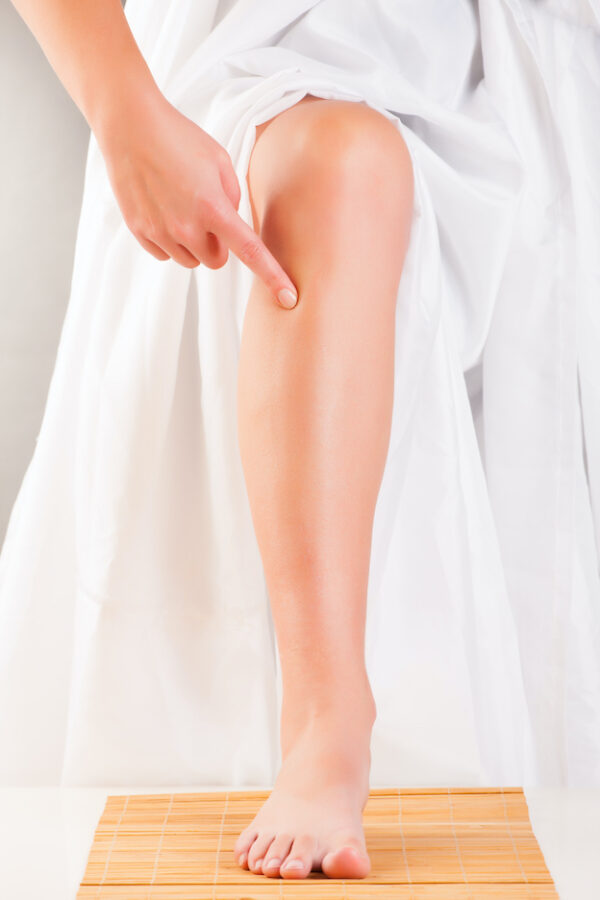
Stomach 36 is located approximately four finger widths below the bottom edge of the kneecap and one thumb width on the outside or lateral aspect of the shin bone or tibia. It falls into a natural depression between the two bones of the lower leg, the tibia and fibula. This point is often sore, making it relatively easy to find.
Stomach 36 is one of the strongest points for boosting immunity. It stimulates the body’s energy (or qi), benefits digestion, treats vomiting, diarrhea, and constipation, and calms the mind. It is also an excellent point to stimulate regularly to boost energy and keep your defenses strong.
Large Intestine 4
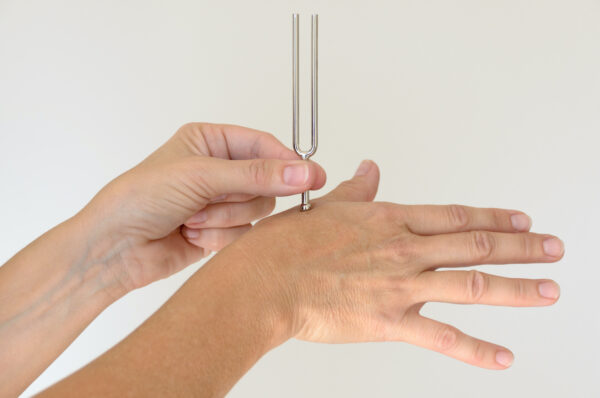
Large intestine 4 is located on the hand between the thumb and the first finger. When you gently press the thumb and first finger together, the point is located at the highest point of the mound created. This point is sore on almost everyone and can be quite strong when needled, often having an achy, distended feeling.
Although large intestine 4 isn’t a point used specifically to boost the immune system, it is included here for its utility for many conditions, especially cold and flu symptoms. Master point for the head and face, large intestine 4 treats headaches, dizziness, congestion, swelling, and pain. It is also a point used for pain anywhere in the body, which helps treat the aches and pains associated with colds and flu.
Large Intestine 11
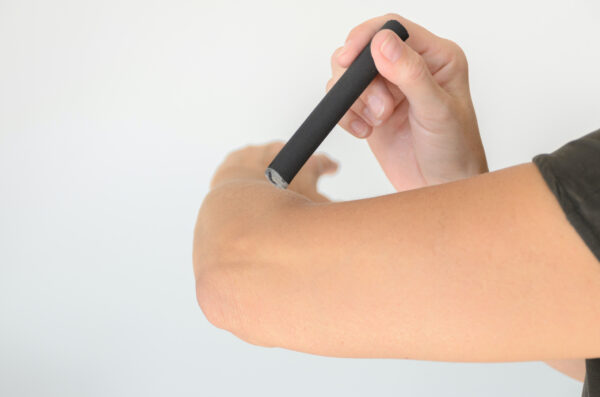
Large intestine 11 is located on the arm at the end of the crease created when you bend at the elbow. The point is on the radial side, the same side as the thumb, on the outside of the arm. If you bend your arm completely at the elbow, the point is located right at the end of the crease and is quite tender on most people.
Large intestine 11 is an excellent point for clearing heat in the body and is used for reducing fevers. It is known to drain the heat causing sore throat and toothache and treats many skin conditions with heat as their source. It is a strong point for boosting the immune system and preventing colds and flu.
Kidney 27

Kidney 27 is located on the chest, just below the collarbone, about two thumb widths from the midline. This point falls into a depression between the first intercostal space—between the clavicle and the first rib. This point is generally tender to the touch and even more so if you have an upper respiratory tract infection.
Kidney 27 is indicated for problems of the chest, like cough, wheezing, phlegm, and chest pain. Kidney 27 strongly stimulates the immune system and is excellent for those suffering from upper respiratory tract infections like bronchitis. It is also a good point to stop vomiting.
Acupressure–The Method
You can do acupressure on these points anytime you feel run down or are sick and want to recover more quickly.
Make sure you have about 15 minutes to do the protocol so you are relaxed and don’t feel rushed.
You can start on the leg with stomach 36 and work up to kidney 27 on the chest. Starting at the bottom and working your way up, this would be the order:
- Stomach 36
- Large intestine 4
- Large intestine 11
- Kidney 27
All the points are bilateral, meaning they are on both sides of the body, so you want to do each point on both sides before moving on to the next one.
Apply pressure (whatever amount is comfortable) for 30 seconds on each point. Do both sides, then move on to the next point in the sequence.
Cycle through the points until you have done all four. You can do this once or twice a day or as needed.
Final Thoughts
The common illnesses we encounter seem an inevitable part of life. And while we probably avoid them sometimes if we are built up enough—eating well, managing stress, and getting enough sleep—there are times we will succumb, no matter how hard we try. I always like to use natural approaches and support the body’s healing ability before I turn to medications. Nature possesses an enormous reservoir of healing wisdom if we know to use it.
For some more ideas about natural approaches to common illnesses, see 6 Medicinal Herbs You Should be Growing in Your Garden and Natural Ways to Help Fight Colds and Flu This Fall.





